Construction of Wetland Ecological Security Pattern in Wuhan Metropolitan Core Area Considering Wetland Ecological Risk
Abstract
:1. Introduction
2. Materials and Methods
2.1. Data Sources
2.2. Research Framework
2.3. Research Methods
2.3.1. Wetland Ecological Risk Assessment System
- (1)
- External Hazard Indicators and Calculation Methods
- (2)
- Internal Vulnerability Indicators and Calculation Methods
2.3.2. Construction and Optimization of Wetland Ecological Security Pattern Integrating Wetland Ecological Risk
- (1)
- Selection of Ecological Source Areas
- (2)
- Resistance Surface Construction
- (3)
- Ecological Corridor and Ecological Node Construction
3. Results
3.1. Wetland Ecological Risk Evaluation Results
3.1.1. Spatial Distribution of External Hazard
3.1.2. Spatial Distribution of Internal Vulnerability
3.1.3. Spatial Distribution of Wetland Ecological Risk
3.2. Construction of Wetland Ecological Security Pattern in the Wuhan Metropolitan Core Area
3.2.1. Wetland Ecological Source in the Wuhan Metropolitan Core Area
3.2.2. Construction of Wetland Ecological Resistance Surface in the Wuhan Metropolitan Core Area
3.2.3. Construction and Optimization of the Wetland Ecological Security Pattern in the
Wuhan Metropolitan Core Area
3.2.4. Wetland Optimization Strategies Guided by Ecological Risks and Security Patterns of Wetlands in the Wuhan Metropolitan Core Area
4. Discussion
4.1. Analysis of the Framework for Constructing the Ecological Security Pattern Considering the Ecological Risk of Wetlands
4.2. Discussion and Analysis of Ecological Risks of Wetlands in the Wuhan Metropolitan Core Area
4.3. Discussion on the Optimization Strategy of the Wetland Ecological Security Pattern in the Wuhan Metropolitan Core Area
5. Conclusions
- (1)
- The overall wetland ecological risk assessment of wetlands in the Wuhan metropolitan core area found that the spatial distribution of ecological risk exhibits a ring-shaped risk gradient pattern centered on Wuhan and other large cities. The high-risk areas are mainly distributed in the central urban area and surrounding areas of Wuhan, the higher-risk areas are mainly the transition zone between the urban fringe and the agricultural development zone, and the medium- and low-risk areas are concentrated in the mountainous areas in the north and south of the region, as well as some well-protected wetland areas.
- (2)
- The ecological network of wetlands in the Wuhan metropolitan core area as a whole shows the spatial structure of the wetland corridor of the Yangtze River mainstem spreading to the surrounding mountains and plains, with 137 ecological sources selected, 10 major ecological corridors constructed, and 62 ecological nodes needing to be protected.
- (3)
- We combine the results of ecological risk assessment with the wetland ecological security pattern construction plan to develop an integrated management assessment framework, providing targeted optimization strategies for regional wetland ecological spaces. This promotes cross-regional coordination and cooperation, enhances wetland protection levels, and drives ecologically sustainable development.
Author Contributions
Funding
Data Availability Statement
Acknowledgments
Conflicts of Interest
References
- Costanza, R. Nature: Ecosystems without Commodifying Them. Nature 2006, 443, 749. [Google Scholar] [CrossRef] [PubMed]
- Chen, L.; Ma, Y. Ecological Risk Identification and Ecological Security Pattern Construction of Productive Wetland Landscape. Water Resour. Manag. 2023, 37, 4709–4731. [Google Scholar] [CrossRef]
- Salimi, S.; Almuktar, S.A.A.A.N.; Scholz, M. Impact of Climate Change on Wetland Ecosystems: A Critical Review of Experimental Wetlands. J. Environ. Manag. 2021, 286, 112160. [Google Scholar] [CrossRef] [PubMed]
- Murray, N.J.; Phinn, S.R.; DeWitt, M.; Ferrari, R.; Johnston, R.; Lyons, M.B.; Clinton, N.; Thau, D.; Fuller, R.A. The Global Distribution and Trajectory of Tidal Flats. Nature 2019, 565, 222–225. [Google Scholar] [CrossRef]
- Jiang, T.; Pan, J.; Pu, X.-M.; Wang, B.; Pan, J.-J. Current Status of Coastal Wetlands in China: Degradation, Restoration, and Future Management. Estuar. Coast. Shelf Sci. 2015, 164, 265–275. [Google Scholar] [CrossRef]
- Fluet-Chouinard, E.; Stocker, B.D.; Zhang, Z.; Malhotra, A.; Melton, J.R.; Poulter, B.; Kaplan, J.O.; Goldewijk, K.K.; Siebert, S.; Minayeva, T.; et al. Extensive Global Wetland Loss over the Past Three Centuries. Nature 2023, 614, 281–286. [Google Scholar] [CrossRef]
- Liu, H.; Lin, Z.; Wang, W. Research Progress and Development Prospect of Wetland Resources. J. Nat. Resour. 2009, 24, 2204–2212. [Google Scholar]
- Liu, L.; Wang, H.; Yue, Q. China’s Coastal Wetlands: Ecological Challenges, Restoration, and Management Suggestions. Reg. Stud. Mar. Sci. 2020, 37, 101337. [Google Scholar] [CrossRef]
- Xiao, T.; Shi, Q.; Wen, Y.; Song, S.; Wang, Z.; Zeng, M. Progress and perspectives in the research of wetland ecosystem services. Shengtaixue Zazhi 2022, 41, 1205–1212. [Google Scholar] [CrossRef]
- Xu, T.; Weng, B.; Yan, D.; Wang, K.; Li, X.; Bi, W.; Li, M.; Cheng, X.; Liu, Y. Wetlands of International Importance: Status, Threats, and Future Protection. Int. J. Environ. Res. Public Health 2019, 16, 1818. [Google Scholar] [CrossRef]
- Pimm, S.L. The Complexity and Stability of Ecosystems. Nature 1984, 307, 321–326. [Google Scholar] [CrossRef]
- Kang, P.; Chen, W.; Hou, Y.; Li, Y. Linking Ecosystem Services and Ecosystem Health to Ecological Risk Assessment: A Case Study of the Beijing-Tianjin-Hebei Urban Agglomeration. Sci. Total Environ. 2018, 636, 1442–1454. [Google Scholar] [CrossRef] [PubMed]
- Wang, H.; Song, C.; Song, K. Regional Ecological Risk Assessment of Wetlands in the Sanjiang Plain with Respect to Human Disturbance. Sustainability 2020, 12, 1974. [Google Scholar] [CrossRef]
- Mao, D.; Wang, Z.; Wu, J.; Wu, B.; Zeng, Y.; Song, K.; Yi, K.; Luo, L. China’s Wetlands Loss to Urban Expansion. Land Degrad Dev 2018, 29, 2644–2657. [Google Scholar] [CrossRef]
- Qian, Y.; Liu, D.; Lou, Y.; Chen, H.; Zhou, G.; Chen, G. A review of wetland ecological status evaluation in China. Acta Ecol. Sin. 2019, 39, 3372–3382. [Google Scholar]
- Zhang, C.; Dong, B.; Liu, L.; Peng, W.; Chen, C.; Zhou, Q.; Wang, Q.; Li, J.; Wang, C.; Huang, H.; et al. Study on Ecological Risk Assessment for Land-Use of Wetland Based on Different Scale. J. Indian Soc. Remote Sens. 2016, 44, 821–828. [Google Scholar] [CrossRef]
- Zhang, Y.; Yan, J.; Cheng, X. Advances in impact of climate change and human activities on wetlands on the Tibetan Plateau. Acta Ecol. Sin. 2023, 43, 2180–2193. [Google Scholar]
- Zhou, D.; Shi, P.; Wu, X.; Ma, J.; Yu, J. Effects of Urbanization Expansion on Landscape Pattern and Region Ecological Risk in Chinese Coastal City: A Case Study of Yantai City. Sci. World J. 2014, 821781. [Google Scholar] [CrossRef] [PubMed]
- Cheng, H.; Zhu, L.; Meng, J. Fuzzy Evaluation of the Ecological Security of Land Resources in Mainland China Based on the Pressure-State-Response Framework. Sci. Total Environ. 2022, 804, 150053. [Google Scholar] [CrossRef]
- Li, S.; Tu, B.; Zhang, Z.; Wang, L.; Zhang, Z.; Che, X.; Wang, Z. Exploring New Methods for Assessing Landscape Ecological Risk in Key Basin. J. Clean. Prod. 2024, 461, 142633. [Google Scholar] [CrossRef]
- Duan, H.; Yu, X.; Zhang, L.; Xia, S.; Liu, Y.; Mao, D.; Zhang, G. An Evaluating System for Wetland Ecological Risk: Case Study in Coastal Mainland China. Sci. Total Environ. 2022, 828, 154535. [Google Scholar] [CrossRef] [PubMed]
- Li, Z.; Jiang, W.; Wang, W.; Chen, Z.; Ling, Z.; Lv, J. Ecological Risk Assessment of the Wetlands in Beijing-Tianjin-Hebei Urban Agglomeration. Ecol. Indic. 2020, 117, 106677. [Google Scholar] [CrossRef]
- Wang, Y.; Pan, J. Building Ecological Security Patterns Based on Ecosystem Services Value Reconstruction in an Arid Inland Basin: A Case Study in Ganzhou District, NW China. J. Clean. Prod. 2019, 241, 118337. [Google Scholar] [CrossRef]
- Solovjova, N.V. Synthesis of Ecosystemic and Ecoscreening Modelling in Solving Problems of Ecological Safety. Ecol. Model. 1999, 124, 1–10. [Google Scholar] [CrossRef]
- Dong, R.; Zhang, X.; Li, H. Constructing the Ecological Security Pattern for Sponge City: A Case Study in Zhengzhou, China. Water 2019, 11, 284. [Google Scholar] [CrossRef]
- Su, Y.; Chen, X.; Liao, J.; Zhang, H.; Wang, C.; Ye, Y.; Wang, Y. Modeling the Optimal Ecological Security Pattern for Guiding the Urban Constructed Land Expansions. Urban For. Urban Green. 2016, 19, 35–46. [Google Scholar] [CrossRef]
- Mu, H.; Li, X.; Ma, H.; Du, X.; Huang, J.; Su, W.; Yu, Z.; Xu, C.; Liu, H.; Yin, D.; et al. Evaluation of the Policy-Driven Ecological Network in the Three-North Shelterbelt Region of China. Landsc. Urban Plan. 2022, 218, 104305. [Google Scholar] [CrossRef]
- Tu, Y.; Liu, M.; Gao, C.; Sun, Y.; Cai, C.; Su, L. Construction of ecological sources identification system for metropolitan areas and diagnosis of key areas for ecological restoration in nationally spatial areas. Acta Ecol. Sin. 2022, 42, 7056–7067. [Google Scholar]
- Zhou, G.; Huan, Y.; Wang, L.; Lan, Y.; Liang, T.; Shi, B.; Zhang, Q. Linking Ecosystem Services and Circuit Theory to Identify Priority Conservation and Restoration Areas from an Ecological Network Perspective. Sci. Total Environ. 2023, 873, 162261. [Google Scholar] [CrossRef]
- Fan, F.; Wen, X.; Feng, Z.; Gao, Y.; Li, W. Optimizing Urban Ecological Space Based on the Scenario of Ecological Security Patterns: The Case of Central Wuhan, China. Appl. Geogr. 2022, 138, 102619. [Google Scholar] [CrossRef]
- Huang, L.; Lu, Y.; Wang, J. Linking G2SFCA Method and Circuit Theory to Promote Spatial Equity and Landscape Connectivity in Urban Ecological Infrastructure. J. Environ. Manag. 2023, 348, 119208. [Google Scholar] [CrossRef] [PubMed]
- Li, F.; Ye, Y.; Song, B.; Wang, R. Evaluation of Urban Suitable Ecological Land Based on the Minimum Cumulative Resistance Model: A Case Study from Changzhou, China. Ecol. Model. 2015, 318, 194–203. [Google Scholar] [CrossRef]
- Peng, S.; Lin, X.; Thompson, R.L.; Xi, Y.; Liu, G.; Hauglustaine, D.; Lan, X.; Poulter, B.; Ramonet, M.; Saunois, M.; et al. Wetland Emission and Atmospheric Sink Changes Explain Methane Growth in 2020. Nature 2022, 612, 477–482. [Google Scholar] [CrossRef] [PubMed]
- Hubei Provincial Ecological Environment Department. Hubei Wetland Protection Plan (2023–2030); Hubei Provincial Ecological Environment Department: Wuhan, China, 2023. [Google Scholar]
- Zhu, Z.; He, Q. Spatio-Temporal Evaluation of the Urban Agglomeration Expansion in the Middle Reaches of the Yangtze River and Its Impact on Ecological Lands. Sci. Total Environ. 2021, 790, 148150. [Google Scholar] [CrossRef]
- Meng, W.; He, M.; Hu, B.; Mo, X.; Li, H.; Liu, B.; Wang, Z. Status of Wetlands in China: A Review of Extent, Degradation, Issues and Recommendations for Improvement. Ocean Coast. Manag. 2017, 146, 50–59. [Google Scholar] [CrossRef]
- Department of Natural Resources of Hubei Province. Bulletin of the First National Geographic Census of Hubei Province; Department of Natural Resources of Hubei Province: Wuhan, China, 2017. [Google Scholar]
- Wang, M.; Mao, D.; Wang, Y.; Song, K.; Yan, H.; Jia, M.; Wang, Z. Annual Wetland Mapping in Metropolis by Temporal Sample Migration and Random Forest Classification with Time Series Landsat Data and Google Earth Engine. Remote Sens. 2022, 14, 3191. [Google Scholar] [CrossRef]
- Gao, X.; Zhang, A.; Sun, Z. How Regional Economic Integration Influence on Urban Land Use Efficiency? A Case Study of Wuhan Metropolitan Area, China. Land Use Policy 2020, 90, 104329. [Google Scholar] [CrossRef]
- Norton, S.B.; Rodier, D.J.; van der Schalie, W.H.; Wood, W.P.; Slimak, M.W.; Gentile, J.H. A Framework for Ecological Risk Assessment at the EPA. Environ. Toxicol. Chem. 1992, 11, 1663–1672. [Google Scholar] [CrossRef]
- Muro, J.; Strauch, A.; Heinemann, S.; Steinbach, S.; Thonfeld, F.; Waske, B.; Diekkrüger, B. Land Surface Temperature Trends as Indicator of Land Use Changes in Wetlands. Int. J. Appl. Earth Obs. Geoinf. 2018, 70, 62–71. [Google Scholar] [CrossRef]
- Wu, H.; Guo, B.; Fan, J.; Yang, F.; Han, B.; Wei, C.; Lu, Y.; Zang, W.; Zhen, X.; Meng, C. A Novel Remote Sensing Ecological Vulnerability Index on Large Scale: A Case Study of the China-Pakistan Economic Corridor Region. Ecol. Indic. 2021, 129, 107955. [Google Scholar] [CrossRef]
- Luo, J.; Zhu, L.; Fu, H. Construction of Wetland Ecological Network Based on MSPA-Conefor-MCR: A Case Study of Haikou City. Ecol. Indic. 2024, 166, 112329. [Google Scholar] [CrossRef]
- Xu, E.; Zhang, H. Aggregating Land Use Quantity and Intensity to Link Water Quality in Upper Catchment of Miyun Reservoir. Ecol. Indic. 2016, 66, 329–339. [Google Scholar] [CrossRef]
- Li, F.; Zhang, S.; Yang, J.; Bu, K.; Wang, Q.; Tang, J.; Chang, L. The Effects of Population Density Changes on Ecosystem Services Value: A Case Study in Western Jilin, China. Ecol. Indic. 2016, 61, 328–337. [Google Scholar] [CrossRef]
- Hu, C. A Novel Ocean Color Index to Detect Floating Algae in the Global Oceans. Remote Sens. Environ. 2009, 113, 2118–2129. [Google Scholar] [CrossRef]
- Kang, L.; Yang, X.; Gao, X.; Zhang, J.; Zhou, J.; Hu, Y.; Chi, H. Landscape Ecological Risk Evaluation and Prediction under a Wetland Conservation Scenario in the Sanjiang Plain Based on Land Use/Cover Change. Ecol. Indic. 2024, 162, 112053. [Google Scholar] [CrossRef]
- Xie, H.; He, Y.; Choi, Y.; Chen, Q.; Cheng, H. Warning of Negative Effects of Land-Use Changes on Ecological Security Based on GIS. Sci. Total Environ. 2020, 704, 135427. [Google Scholar] [CrossRef]
- Karimian, H.; Zou, W.; Chen, Y.; Xia, J.; Wang, Z. Landscape Ecological Risk Assessment and Driving Factor Analysis in Dongjiang River Watershed. Chemosphere 2022, 307, 135835. [Google Scholar] [CrossRef] [PubMed]
- Huang, L.; Yuan, L.; Xia, Y.; Yang, Z.; Luo, Z.; Yan, Z.; Li, M.; Yuan, J. Landscape Ecological Risk Analysis of Subtropical Vulnerable Mountainous Areas from a Spatiotemporal Perspective: Insights from the Nanling Mountains of China. Ecol. Indic. 2023, 154, 110883. [Google Scholar] [CrossRef]
- Colding, J. ‘Ecological Land-Use Complementation’ for Building Resilience in Urban Ecosystems. Landsc. Urban Plan. 2007, 81, 46–55. [Google Scholar] [CrossRef]
- Xie, G.; Lin, Z. Research on evaluation and accounting of ecosystem assets and services. China Soft Sci. 2024, 39, 388–393. [Google Scholar]
- Ding, G.; Yi, D.; Yi, J.; Guo, J.; Ou, M.; Ou, W.; Tao, Y.; Pueppke, S.G. Protecting and Constructing Ecological Corridors for Biodiversity Conservation: A Framework That Integrates Landscape Similarity Assessment. Appl. Geogr. 2023, 160, 103098. [Google Scholar] [CrossRef]
- Yu, K. Methods for Identifying Strategic Points in Landscape Ecology and the Surface Model of Theoretical Geography. J. Geogr. Sci. 1998, 11–20. [Google Scholar]
- Cao, C.; Luo, Y.; Xu, L.; Xi, Y.; Zhou, Y. Construction of Ecological Security Pattern Based on InVEST-Conefor-MCRM: A Case Study of Xinjiang, China. Ecol. Indic. 2024, 159, 111647. [Google Scholar] [CrossRef]
- Zeng, L.; Yang, Q.-Y.; Yang, R.-H.; Chen, Y.-D. Landscape Pattern Optimization For Ecological Barrier In The Three Gorges Reservoir Area: A Case Study In Jiangjin, Chongqing. Chin. J. Ecol. 2017, 36, 1364–1373. [Google Scholar] [CrossRef]
- Zhang, Z.; Gong, J.; Plaza, A.; Yang, J.; Li, J.; Tao, X.; Wu, Z.; Li, S. Long-Term Assessment of Ecological Risk Dynamics in Wuhan, China: Multi-Perspective Spatiotemporal Variation Analysis. Environ. Impact Assess. Rev. 2024, 105, 107372. [Google Scholar] [CrossRef]
- Zeng, W.; He, Z.; Bai, W.; He, L.; Chen, X.; Chen, J. Identification of Ecological Security Patterns of Alpine Wetland Grasslands Based on Landscape Ecological Risks: A Study in Zoigê County. Sci. Total Environ. 2024, 928, 172302. [Google Scholar] [CrossRef]
- Zhang, W.; Liu, G.; Ghisellini, P.; Yang, Z. Ecological Risk and Resilient Regulation Shifting from City to Urban Agglomeration: A Review. Environ. Impact Assess. Rev. 2024, 105, 107386. [Google Scholar] [CrossRef]
- Fan, S.; Yan, M.; Yu, L.; Chen, B.; Zhang, L. Integrating Ecosystem Service Supply–Demand and Ecological Risk Assessment for Urban Planning: A Case Study in Beijing, China. Ecol. Indic. 2024, 161, 111950. [Google Scholar] [CrossRef]
- Huang, L.; Chen, Z.; Yang, Z.; Chen, M.; Chen, X.; Zhai, T.; Qiu, T. Integrating “Quality-Risk-Demand” Framework and Circuit Theory to Identify Spatial Range and Priority Area of Ecological Security Pattern in a Rapidly Urbanizing Landscape. Ecol. Inform. 2024, 82, 102673. [Google Scholar] [CrossRef]
- Alikhani, S.; Nummi, P.; Ojala, A. Urban Wetlands: A Review on Ecological and Cultural Values. Water 2021, 13, 3301. [Google Scholar] [CrossRef]
- Han, P.; Xiong, H.; Hu, H.; Zhou, J.; Wang, M. Integrating Risk-Conflict Assessment for Constructing and Optimizing Ecological Security Patterns of Polder Landscape in the Urban-Rural Fringe. Ecol. Indic. 2024, 166, 112256. [Google Scholar] [CrossRef]
- Wei, Y.; Zhou, P.; Zhang, L.; Zhang, Y. Spatio-Temporal Evolution Analysis of Land Use Change and Landscape Ecological Risks in Rapidly Urbanizing Areas Based on Multi-Situation Simulation − a Case Study of Chengdu Plain. Ecol. Indic. 2024, 166, 112245. [Google Scholar] [CrossRef]
- Lu, Y.; Huang, D.; Liu, Y.; Zhang, Y.; Jing, Y.; Chen, H.; Zhang, Z.; Liu, Y. Exploring the Optimization and Management Methods of Ecological Networks Based on the Cluster Mode: A Case Study of Wuhan Metropolis, China. Land Use Policy 2024, 137, 107021. [Google Scholar] [CrossRef]
- Ozesmi, U. Ecosystems in the Mind: Fuzzy Cognitive Maps of the Kizilirmak Delta Wetlands in Turkey. arXiv 2006. [Google Scholar] [CrossRef]
- García-Herrero, L.; Lavrnić, S.; Guerrieri, V.; Toscano, A.; Milani, M.; Cirelli, G.L.; Vittuari, M. Cost-Benefit of Green Infrastructures for Water Management: A Sustainability Assessment of Full-Scale Constructed Wetlands in Northern and Southern Italy. Ecol. Eng. 2022, 185, 106797. [Google Scholar] [CrossRef]
- Préau, C.; Tournebize, J.; Lenormand, M.; Alleaume, S.; Boussada, V.G.; Luque, S. Habitat Connectivity in Agricultural Landscapes Improving Multi-Functionality of Constructed Wetlands as Nature-Based Solutions. Ecol. Eng. 2022, 182, 106725. [Google Scholar] [CrossRef]
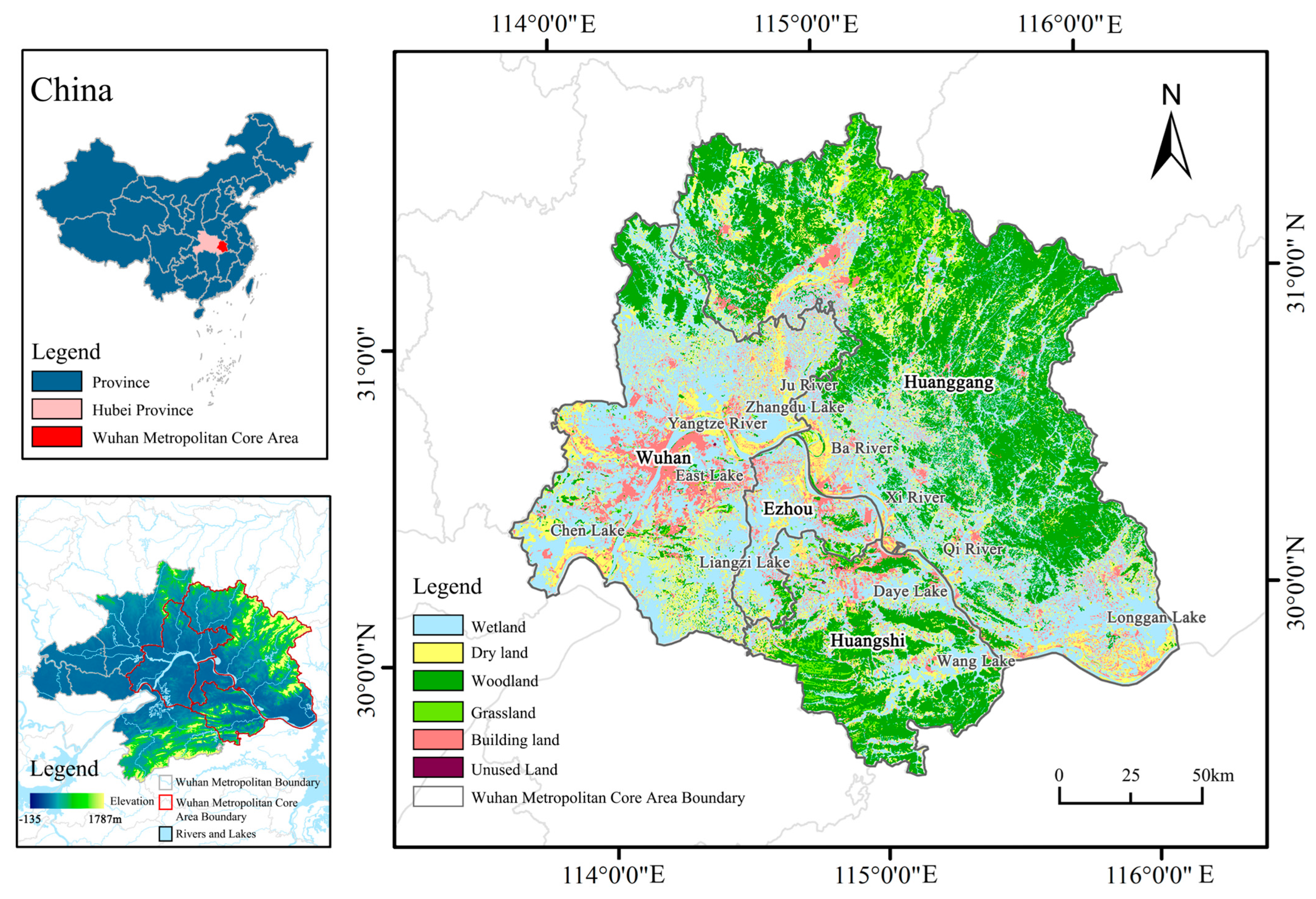

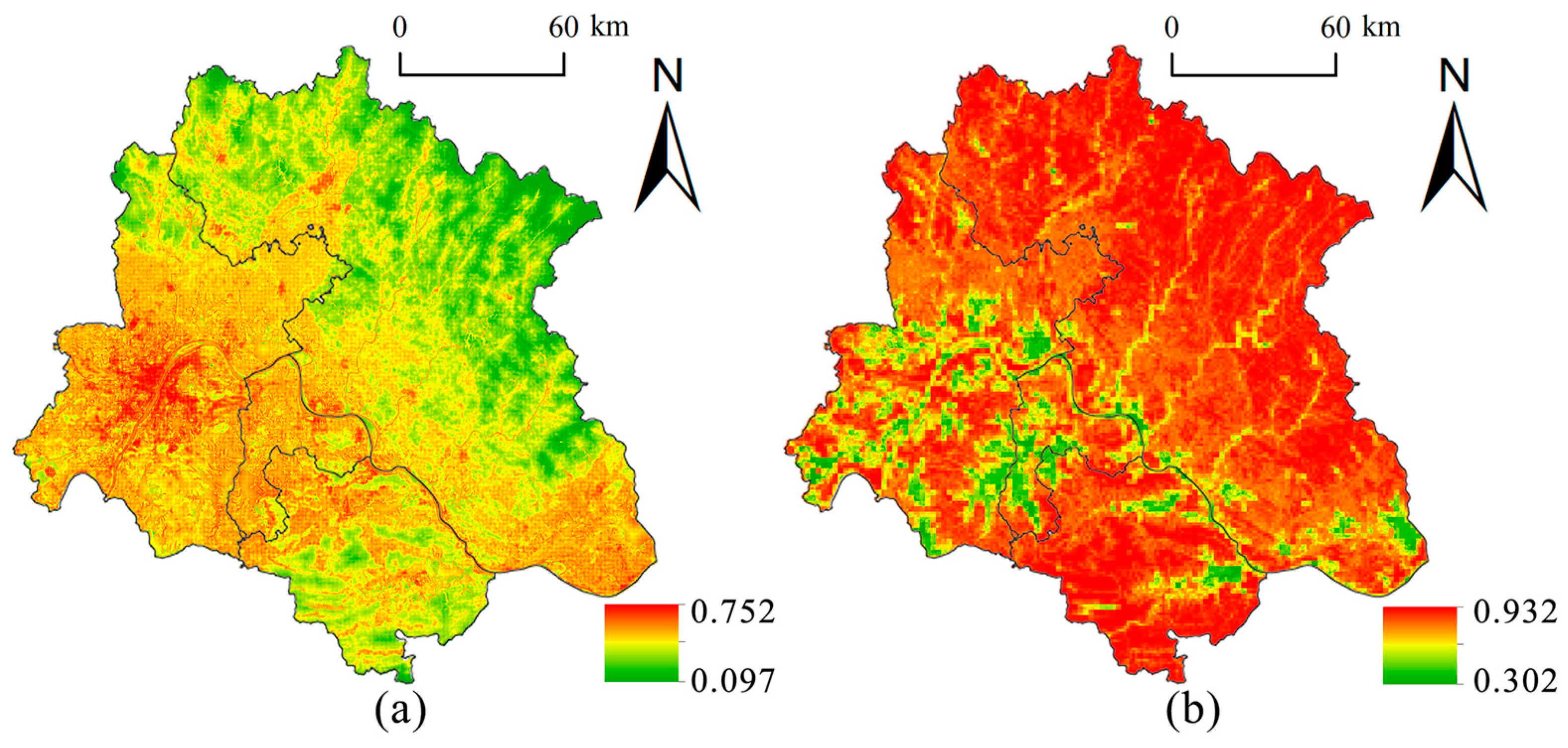
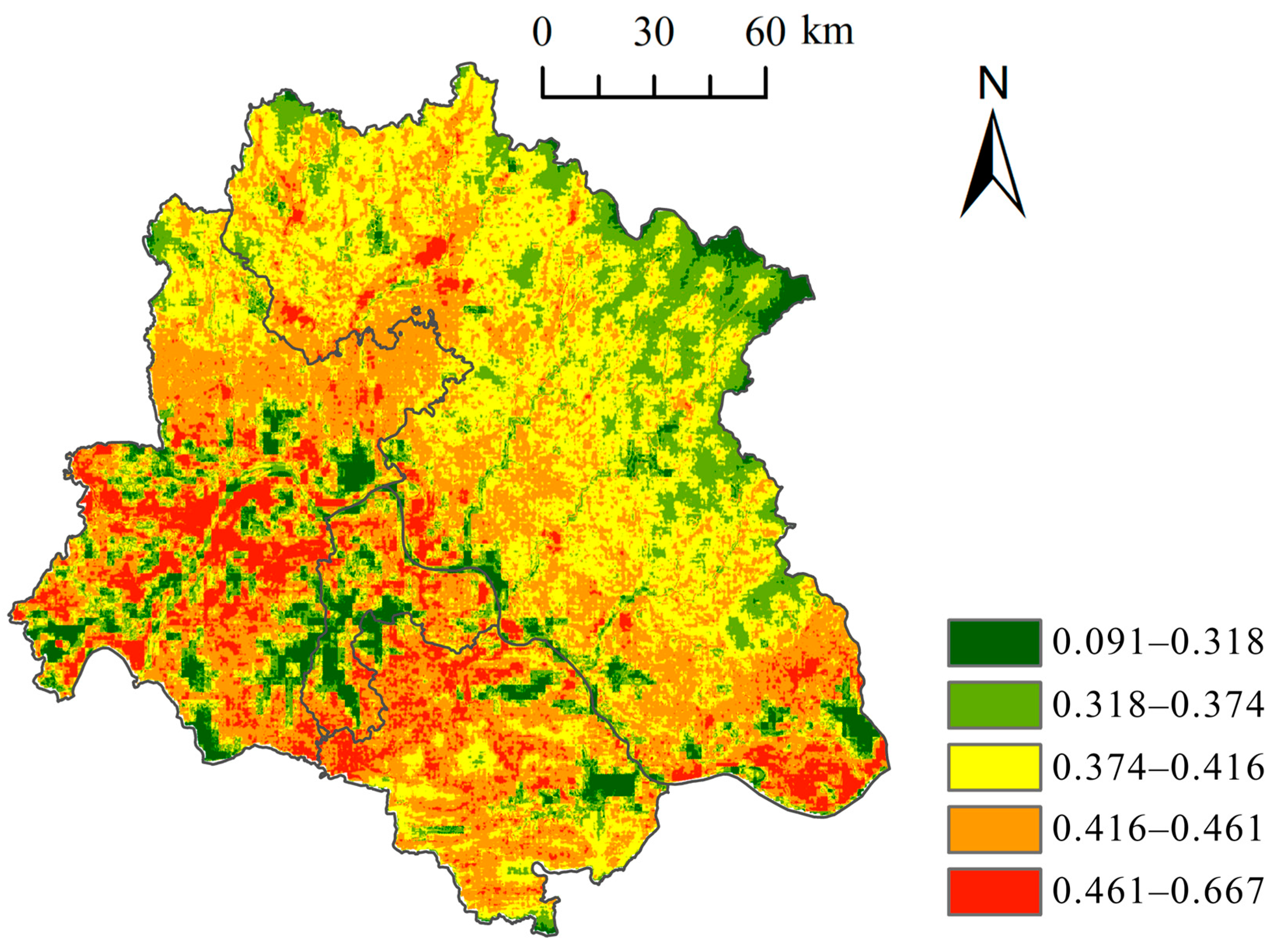
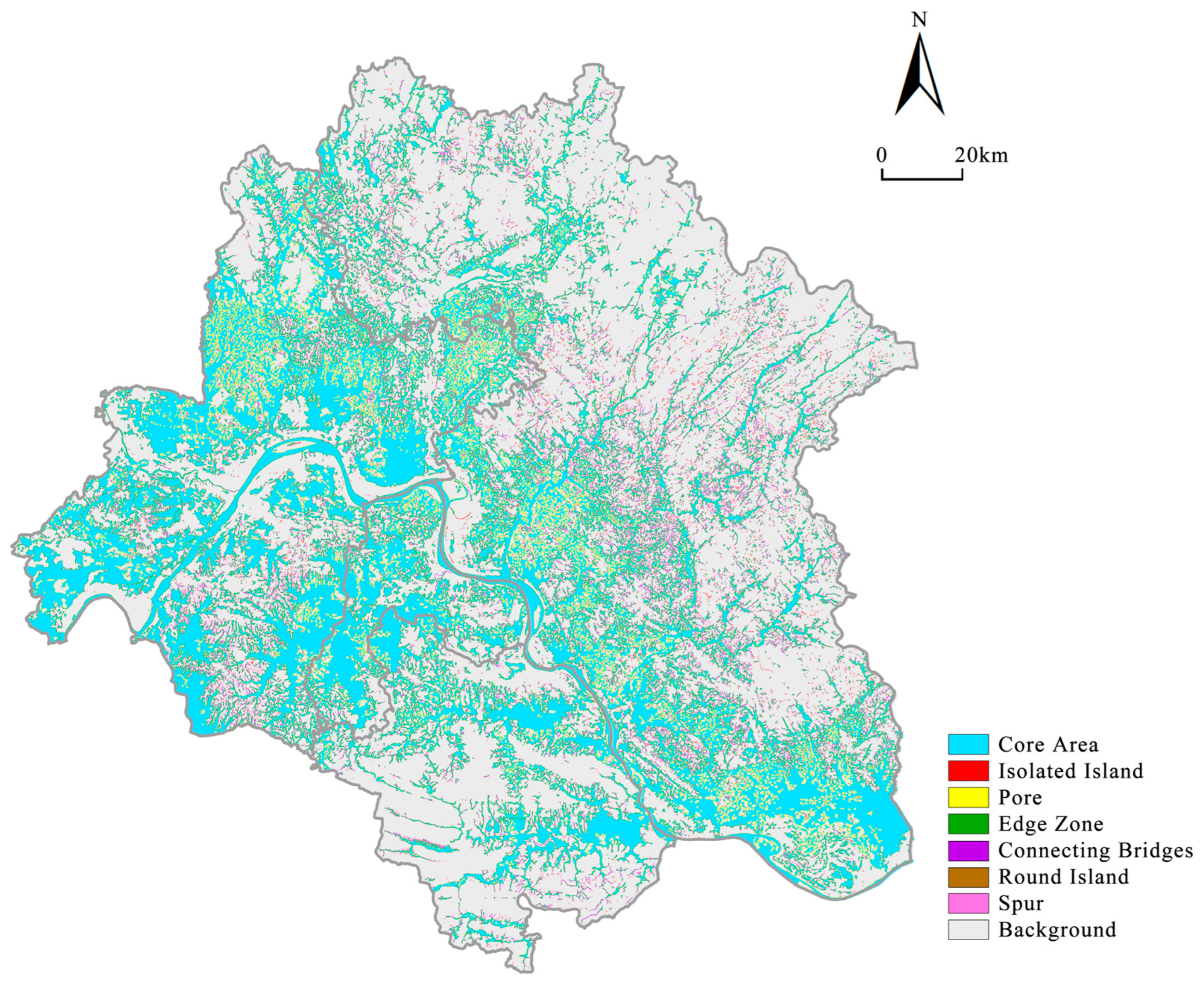

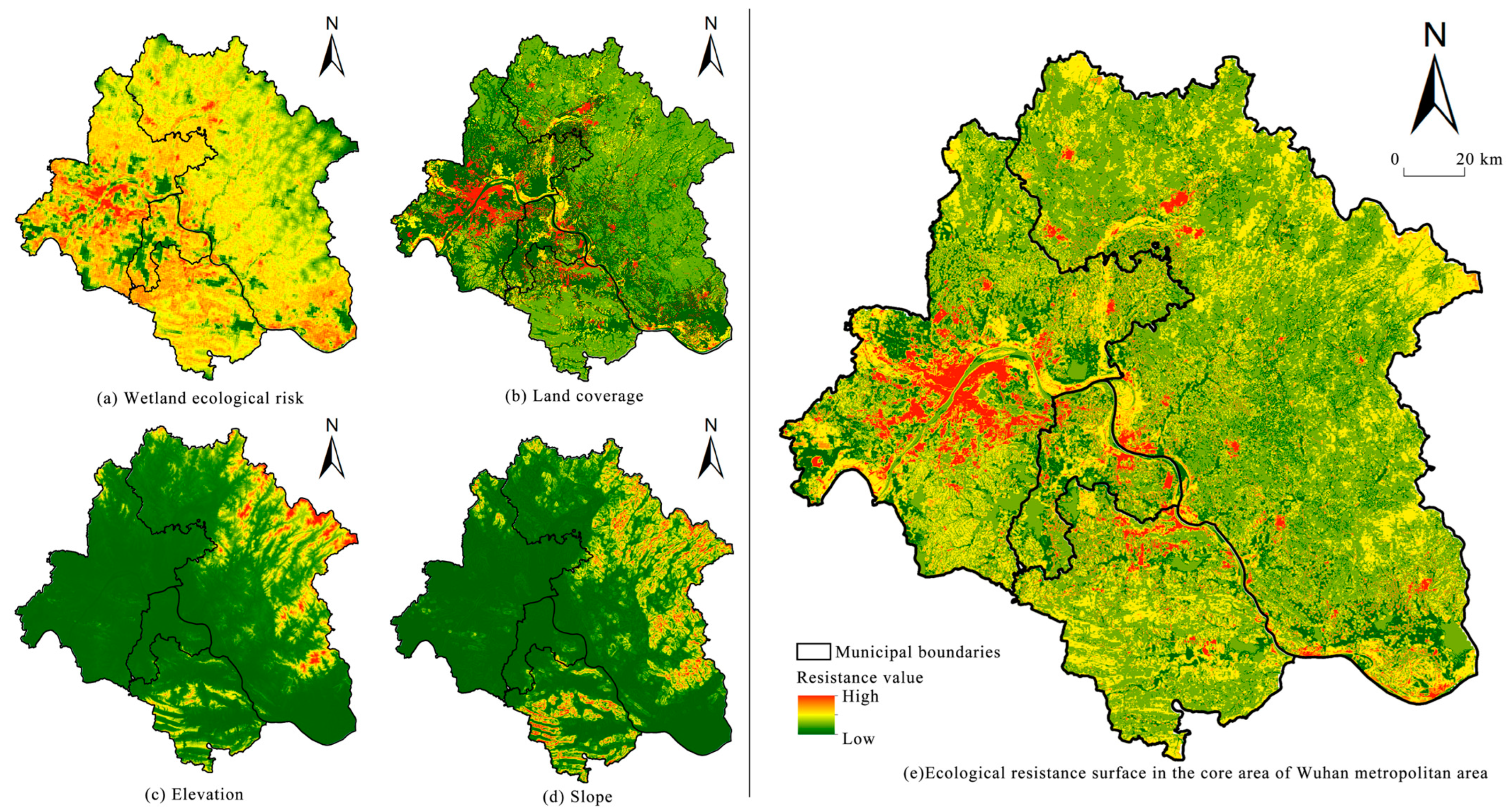
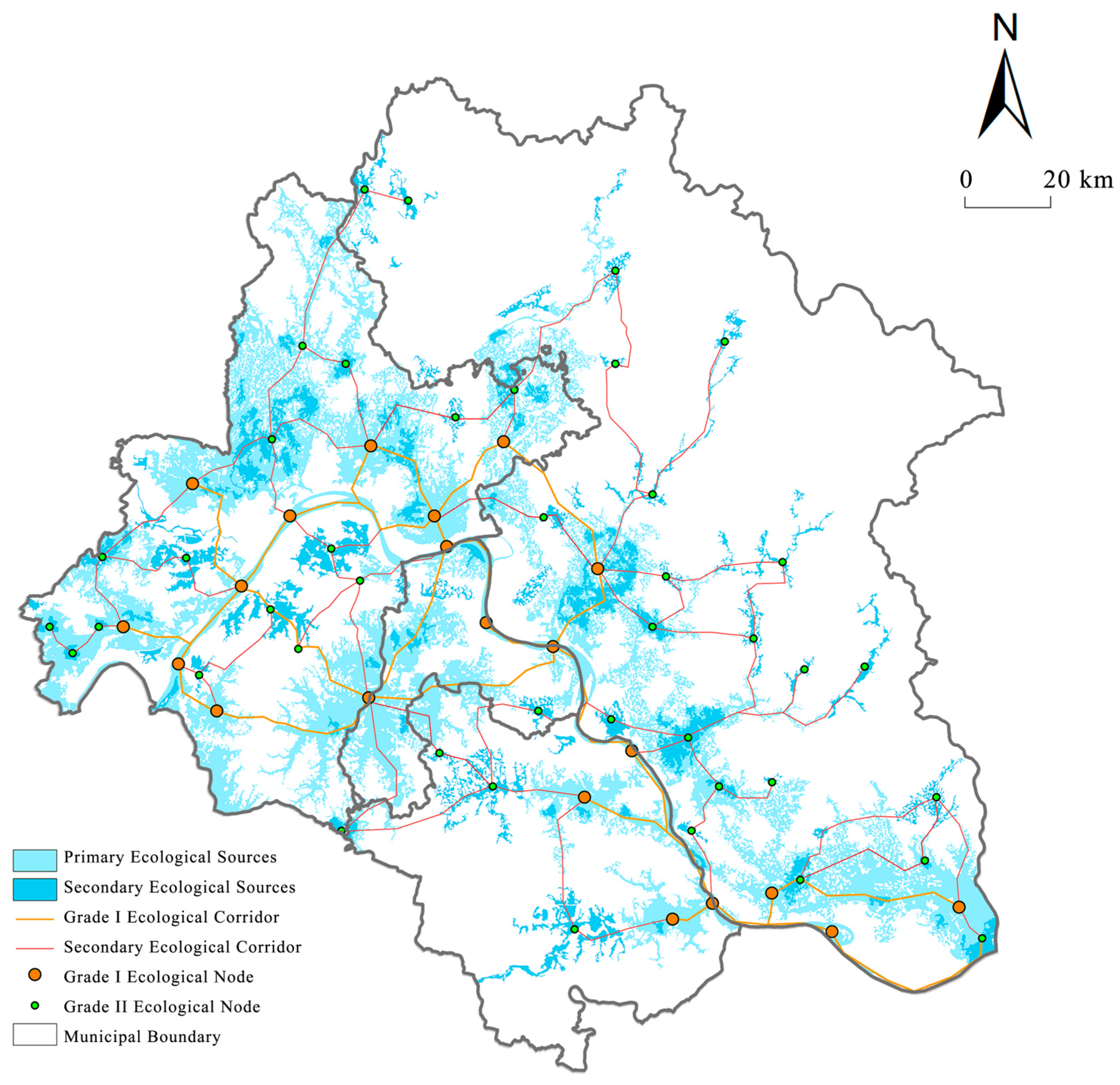
| Composite Index | Objective Level | Criterion Level | Indicator Layer | +/− |
|---|---|---|---|---|
| Wetland Ecological Risk | External hazard | Natural Factors (0.176) | Temperature (0.022) | Positive |
| SPEI (0.047) | Negative | |||
| Rainfall (0.107) | Negative | |||
| Social Factors (0.824) | Nighttime light intensity (0.061) | Positive | ||
| Distance from construction site (0.201) | Positive | |||
| Land use intensity (0.273) | Positive | |||
| Population density (0.149) | Positive | |||
| FAI (0.14) | Positive | |||
| Internalvulnerability | Wetland Spatial Extent (0.102) | Wetland patch size (0.102) | Negative | |
| Wetland Spatial Structure (0.341) | Wetland patch density (0.064) | Negative | ||
| Landscape spreading index (0.035) | Negative | |||
| Landscape separation index (0.068) | Positive | |||
| Landscape shannon diversity index (0.174) | Negative | |||
| Wetland Ecological Function (0.557) | Supply services (0.145) | Negative | ||
| Regulating service (0.126) | Negative | |||
| Supporting services (0.247) | Negative | |||
| Cultural services (0.039) | Negative |
| Land Use Types | Land Use Intensity (LUI) |
|---|---|
| Beach | 1 |
| Marsh | |
| Unused Land | |
| Woodland | 2 |
| Grassland | |
| River and Canal | |
| Lakes | |
| Reservoirs and Ponds | 3 |
| Paddy fields | 4 |
| Dry land | |
| Building land | 5 |
| Level 1 | Level 2 | Paddy Fields | Wetlands | Water Bodies | ||
|---|---|---|---|---|---|---|
| Arid Lands | Paddy Fields | Wetlands | Water Systems | Glacial Snow Packs | ||
| Supply Service | Food Production | 0.85 | 1.36 | 0.51 | 0.8 | 0 |
| Raw material production | 0.4 | 0.09 | 0.5 | 0.23 | 0 | |
| Water supply | 0.02 | −2.63 | 2.59 | 8.29 | 2.16 | |
| Regulating Services | Gas regulation | 0.67 | 1.11 | 1.9 | 0.77 | 0.18 |
| Climate regulation | 0.36 | 0.57 | 3.6 | 2.29 | 0.54 | |
| Environment purification | 0.1 | 0.17 | 3.6 | 5.55 | 0.16 | |
| Hydrological regulation | 0.27 | 2.72 | 24.23 | 102.24 | 7.13 | |
| Supporting Services | Soil conservation | 1.03 | 0.01 | 2.31 | 0.93 | 0 |
| Nutrient cycling maintenance | 0.12 | 0.19 | 0.18 | 0.07 | 0 | |
| Biodiversity maintenance | 0.13 | 0.21 | 7.87 | 2.55 | 0.01 | |
| Cultural Services | Landscape aesthetics | 0.06 | 0.09 | 4.73 | 1.89 | 0.09 |
| Resistance Factor | Weight | Level of Resistance | Value of Resistance |
|---|---|---|---|
| Wetland Ecological Risk | 0.5591 | Low Risk | 1 |
| Relatively Low Risk | 200 | ||
| Medium Risk | 500 | ||
| Relatively High Risk | 800 | ||
| High Risk | 1000 | ||
| Elevation | 0.1445 | <150 m | 100 |
| 150–300 m | 200 | ||
| 300–600 m | 500 | ||
| 600–1000 m | 800 | ||
| >1000m | 1000 | ||
| Slope | 0.1493 | <6 degrees | 100 |
| 6–12 degrees | 200 | ||
| 12–18 degrees | 400 | ||
| 18–24 degrees | 600 | ||
| >24 degrees | 1000 | ||
| Land coverage | 0.1471 | Wetlands | 1 |
| Cropland | 300 | ||
| Woodland | 50 | ||
| Grassland | 100 | ||
| Construction Land | 1000 | ||
| Unused land | 800 |
Disclaimer/Publisher’s Note: The statements, opinions and data contained in all publications are solely those of the individual author(s) and contributor(s) and not of MDPI and/or the editor(s). MDPI and/or the editor(s) disclaim responsibility for any injury to people or property resulting from any ideas, methods, instructions or products referred to in the content. |
© 2024 by the authors. Licensee MDPI, Basel, Switzerland. This article is an open access article distributed under the terms and conditions of the Creative Commons Attribution (CC BY) license (https://creativecommons.org/licenses/by/4.0/).
Share and Cite
Han, P.; Hu, H.; Jiang, M.; Wang, M. Construction of Wetland Ecological Security Pattern in Wuhan Metropolitan Core Area Considering Wetland Ecological Risk. Land 2024, 13, 1407. https://doi.org/10.3390/land13091407
Han P, Hu H, Jiang M, Wang M. Construction of Wetland Ecological Security Pattern in Wuhan Metropolitan Core Area Considering Wetland Ecological Risk. Land. 2024; 13(9):1407. https://doi.org/10.3390/land13091407
Chicago/Turabian StyleHan, Pingyang, Haozhi Hu, Mengting Jiang, and Min Wang. 2024. "Construction of Wetland Ecological Security Pattern in Wuhan Metropolitan Core Area Considering Wetland Ecological Risk" Land 13, no. 9: 1407. https://doi.org/10.3390/land13091407








